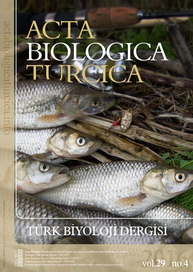Preliminary investigation of the frame net sampling in the pelagic environment of Marmara Sea, Türkiye
Abstract
This study presents the first results of frame net sampling realised in the pelagic environment of the Marmara Sea, Türkiye. Samplings were conducted from 12 stations located in the Marmara Sea with three frame net survey between December 2021 and March 2022. Tows were realised with oblique tows during 10 minutes. A total of 82 individual belonging to 6 varied families and 6 species were identified. The late postlarvae of demersal species distribute pelagic habitat before settlement were found more abundant via pelagic juveniles from the frame net catchs. Although the mean biomass of the species were low, the Gaidropsarus mediterraneus was found the most dominant species. It was found that frame net samplings enable to obtain late postlarvae and early juveniles, which escape from plankton nets due to the high swimming capabilities and escape from seine nets due to the selectivity pattern of commercial nets.
Keywords
Full Text:
PDFReferences
Aoki, I., Miura, T., Imai, N., & Komatsu, T. (2000). Sampling large larvae and juveniles of pelagic fish with a frame-type midwater trawl. Nippon Suisan Gakkaishi, 66(1), 10–17. DOI: 10.2331/suisan.66.10
Daban, İ. B., Şen, Y., Ayaz, A., Altınağaç, U., Öztekin, A., Özekinci, U., İşmen, A., Çakır, F., Yüksek, A., Demirkıran, T., Uğur, G. E. & Selçuk, B. B. (2023). Postmucilage biodiversity of shallow water fish assemblages: A case study in the Marmara Sea, Turkey. Turkish Journal of Zoology, 47(4), 131-201. https://doi.org/10.55730/1300-0179.3132
Hu, F., Oozeki, Y., Tokai, T., & Matsuda, K., (2000). Hydrodynamic characteristics ofcambered V-type depressor for sampling midwater trawl. Nippon Suisan Gakkaishi 66(5), 846–851. DOI: 10.2331/suisan.66.846
Hu, F., Oozeki, Y., Tokai, T., & Matuda, K. (2001). Scale model of a new midwater trawl system for sampling pelagic larval and juvenile fish. Fisheries Science, 67(2), 254-259. https://doi.org/10.1046/j.1444-2906.2001.00247.x
Isaacs, J. D. (1953). Issacs-Kidd midwater trawl. Scripps Inst. Oceanogr. Ref., 53(3), 1-21.
Jenkins, G. P., Black, K. P., Wheatley, M. J., & Hatton, D. N. (1997). Temporal and spatial variability in recruitment of a temperate, seagrass-associated fish is largely determined by physical processes in the pre-and post-settlement phases. Marine Ecology Progress Series, 148, 23-35. doi:10.3354/meps148023
Kara, A. (2015). Investigation of distributions of some teleost fish eggs and/or larvae in the Bay of Erdek. Master's thesis. Istanbul University, Institute of Marine Sciences and Management / Physical Oceanography and Marine Biology. 144 p.
Macpherson, E., & Raventos, N. (2006). Relationship between pelagic larval duration and geographic distribution of Mediterranean littoral fishes. Marine Ecology Progress Series, 327, 257-265. doi:10.3354/meps327257
Methot, R. D. (1986). Frame trawl for sampling pelagic juvenile fish. Calcofi Rep, 27, 267–278.
Oozeki, Y., Hu, F., Kubota, H., Sugisaki, H., & Kimura, R. (2004). Newly designed quantitative frame trawl for sampling larval and juvenile pelagic fish. Fisheries Science, 70(2), 223-232. https://doi.org/10.1111/j.1444-2906.2003.00795.x
Oozeki, Y., Hu, F., Tomatsu, C., & Kubota, H. (2012). Development of a new multiple sampling trawl with autonomous opening/closing net control system for sampling juvenile pelagic fish. Deep Sea Research Part I: Oceanographic Research Papers, 61, 100-108. https://doi.org/10.1016/j.dsr.2011.12.001
Raventos, N., & Macpherson, E. (2001). Planktonic larval duration and settlement marks on the otoliths of Mediterranean littoral fishes. Marine Biology, 138, 1115-1120. DOI: 10.1007/s002270000535
Tucker, G. H. (1951). Relation of fishes and other organisms to the scattering of underwater sound. Journal of Marine Research, 215- 238.
Watanabe, Y., Zenitani, H., & Kimura, R. (1995). Population decline of the Japanese sardine Sardinops melanostictus owing to recruitment failures. Canadian Journal of Fisheries and Aquatic Sciences, 52(8), 1609-1616. https://doi.org/10.1139/f95-154
Refbacks
- There are currently no refbacks.

